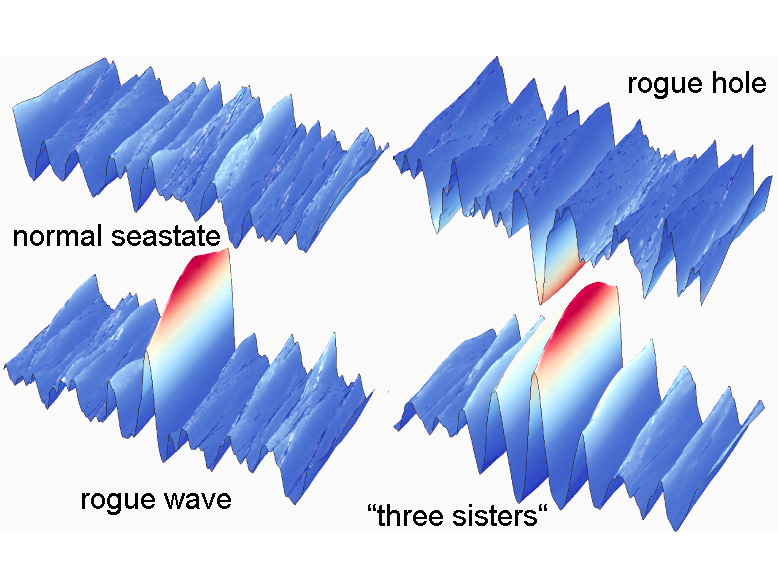Rogue waves are extremely high ocean waves that exceed the significant wave height by more than a factor of 2. Extreme waves are also very rare; less than one in 100,000 waves exceeds the rogue wave criterion. While their existence was long disputed throughout the 1990s, thousands of rogue waves have been recorded on oil rigs in the past 20 years. Nevertheless, the origin of rogue waves is still disputed, with a multitude of competing theories that fall into two basic categories: linear theories consider incidental random interference the origin of rogue waves. This means that it is just bad luck when your ship is hit by a rogue wave. Then nothing can be done to foresee such an event. Recently nonlinear theories gained increasing popularity as they promise that certain characteristic wave patterns may possibly precede a rogue event. While this appears very appealing, neither theory can sufficiently explain the measured probabilities of rogue waves in the ocean.
In a collaborative effort, the group of Günter Steinmeyer at the Max-Born-Institut in Berlin together with colleagues from the Weierstrass Institute, the Leibniz-University in Hannover and the Technical University in Dortmund now report a new approach to shed more light on the rogue wave mystery. To this end, they suggest a new metric for the complexity of the wave motion, namely, the so-called phase space dimension. This metric measures the effective number of waves that interfere at one given location on the ocean surface. More importantly, they also propose a way to measure the dimension, and this measurement could readily be implemented on ships, possibly providing an early warning of rogue waves.
In fact, it seems that the capability of the ocean to form rogue waves is variable. The study suggests that the ocean surface movement is fairly simply structured throughout most of the time. Even in heavy storms, mostly conditions prevail that do not enable rogue wave formation. However, the complexity of the wave patterns may suddenly increase when crossing seas are generated, resulting in rogue-wave prone situations. Using the suggested dimensional analysis, it is exactly these rogue-wave prone situations that can be detected. Nevertheless, the individual rogue wave event remains unforeseeable. Moreover the study suggests that the ocean dynamics are ruled by linear yet still very complex dynamics.
The study therefore opens a new perspective for a better understanding of ocean rogue waves. Much research went into ocean nonlinearities, but it appears that the latter play a minor role for rogue wave formation. In contrast, winds have found very little attention in the rogue wave discussion so far. As winds are ultimately the drivers behind ocean wave formation in general, it therefore seems perfectly possible to identify rogue-wave prone situations from meteorological analysis, identifying situations that may give rise to crossing seas early on. The appearance of an individual rogue wave may remain a mystery, but at least, we may soon be able to predict the "rogueness" of ocean weather hours or days in advance.
Original publication:
Nature / Scientific Reports 6, Article number: 35207 (2016) doi:10.1038/srep35207
Ocean rogue waves and their phase space dynamics in the limit of a linear interference model
Simon Birkholz, Carsten Brée, Ivan Veselic, Ayhan Demircan &
Fig. 1: Numerical simulations of prototypical rogue waves in the ocean.
Top left: Normal sea state. Top right: Rogue hole. Bottom left: Rogue
wave. Bottom right: Rogue wave group, also known as "three sisters".
Ocean nonlinearities are only required to explain why rogue holes are
even more rare than positive rogue waves. Whether rogue waves appear
isolated or in a group depends on the spectral width of the sea state.
Fig
2: Probability of exceeding the significant wave height by a given
factor. Shown are model calculations for a varying number of effectively
interfering waves. If this number is smaller than 10, then no rogue
waves can appear. The danger of rogue wave emergence increases when more
and more waves are interacting with each other. If waves from different
locations propagate towards the same location in the ocean, then the
risk for rogue waves becomes extreme. Also shown for comparison are
results of longterm averaged observations as well as the empirical
Forristall distribution.
Contact:
| Günter Steinmeyer Max-Born-Institut für Nichtlineare Optik und Kurzzeitspektroskopie (MBI) Max-Born-Str. 2A, 12489 Berlin Dr. Günter Steinmeyer phone +49 (0) 30 6392 1440 steinmeymbi-berlin.de |


